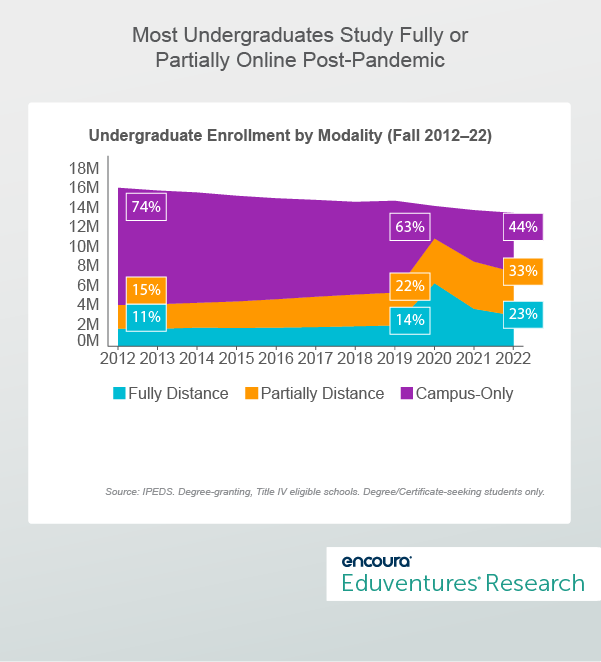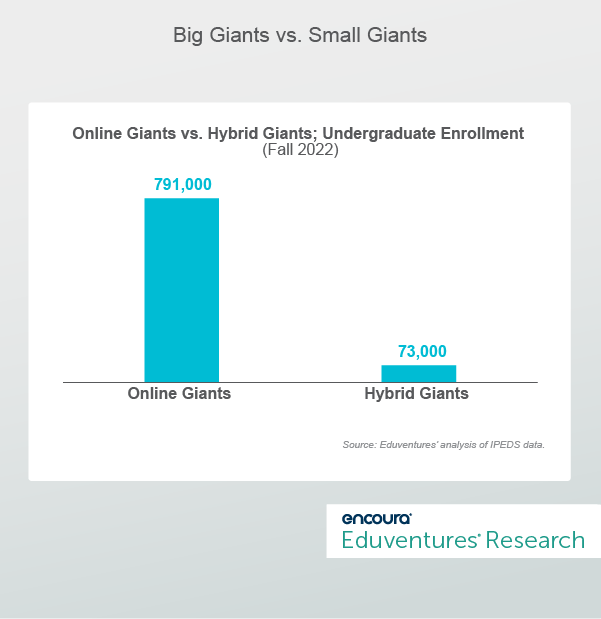Hybrid learning—a combination of campus and online learning, rather than one or the other—has long seemed like a great idea. While students take campus and online courses at the same time, it is hard to find an institution defined by hybrid-as-a-strategy, as opposed to a “kinda-sorta” hybrid approach driven by individual student and faculty choices.
Eduventures has talked up hybrid for over a decade, but few schools have rallied to the cause.
Once again, now seems like a great time for a true hybrid strategy: most colleges have online offerings post-pandemic, but the market is crowded. A hybrid master’s program might offer a more compelling experience than one fully online - and stand out.
Are colleges finally getting strategic about hybrid?
Hybrid Rising
Eduventures’ Adult Prospect Survey™ asked the 55% of adult prospective students (both undergraduate and graduate) who said they preferred hybrid delivery about the reasons for their preferences. The most popular reason (54% of the pro-hybrid group) was perceived flexibility versus the campus norm (rather than students with experience of fully online classes wanting something else). In-person faculty interaction, interest in skills that “cannot be taught online,” and a sense of greater student support came next, each with about 30% allegiance.
Not only do a majority of adult prospects say they prefer a combination of online and on campus, but the literature often lauds superior hybrid student outcomes. However, institutions worried about cost and reach have been wary of hybrid programs, and students opt for the convenience of online or the familiarity of campus. These are the contradictions of hybrid.
What is the latest enrollment data on hybrid? Does it reveal a growing number of institutions defined by hybrid?
The federal government requires colleges to report students as fully distance, partially distance (“some distance” a.k.a. hybrid), or campus-only. Figure 1 shows the undergraduate enrollment distribution over the past decade (for all undergraduates).
Figure 1.
Figure 1 shows that hybrid is rising fast. In 2012, partially-distance enrollment constituted 15% of the undergraduate total, rising to 22% in 2019, and 33% in 2022. Note that total undergraduate degree/certificate-seeking enrollment (which excludes dual enrollment) slipped 16% over the same period.
Before the pandemic, partially-distance enrollment gained ground faster than fully distance (up 47% versus 27%). In 2022—post-pandemic for most—56% of undergraduates were studying either fully or partially at a distance.
Does the hybrid scale and momentum in Figure 1 mean that lots of colleges have genuine hybrid learning strategies? Just as there are “Online Giants” like Western Governors University and Southern New Hampshire University, are there also “Hybrid Giants”?
The (Shy and Not Very Big) “Hybrid Giants”
Hybrid institutions (reportedly) exist.
Yes, many large public institutions report 40-50% “hybrid” students, but none of these schools are yet defined by hybrid. Other kinds of schools present as 100% hybrid.
As of fall 2022, according to IPEDS, there were 157 institutions characterized by fully distance undergraduate delivery, defined by Eduventures as 90% or more of undergraduates reported as fully distance. There were 182 institutions where 90% or more of undergraduates were hybrid.
The leading “Online Giants” are familiar. The “Hybrid Giants” are less well-known. The three largest? Galen College of Nursing, Bethune-Cookman University, and St. Francis College.
The websites of top online schools put online study front-and-center. Modality is fundamental to the brand. How do these “Hybrid Giants” talk about hybrid?
The websites of the top three “Hybrid Giants” barely reference modality at all. Galen leads with commitment to nursing, leaving delivery mode unsaid. The websites of Bethune-Cookman, an HBCU, and St. Francis College, a liberal arts school with a professional orientation, resemble those of peers, with no obvious hybrid element.
In fact, none of the reportedly 10 largest 100% hybrid undergraduate institutions talk up their modality innovation.
What is going on?
Many of the 10 largest undergraduate “Hybrid Giants” are nursing or health sciences institutions. Clinicals are required for licensure, while online classes are a convenient option for busy students. This may be an attractive combination, but these schools do not make modality the selling point.
Students want to become healthcare professionals. Schools may have a carefully crafted “hybrid learning model” to get them there but regard such jargon as marketing clutter. Insiders might call out pedagogic details, but what students care about is finding a high-quality, convenient program. It is what hybrid enables that counts—a blend of campus and online is fundamental but invisible.
There are other explanations for this curious combination of pervasive hybridity and lack of hand-wavering.
The federal definition of “some distance” is simply a student who takes one or more online courses as part of an otherwise campus-based experience. A school that requires all undergraduates to take just one online course might (or might not) report 100% hybrid enrollment but would look quite different from a school with a genuine hybrid strategy.
Some cases of hybrid heft may simply be COVID hangovers. When fall 2023 data is released, apparent hybrid models may prove illusory.
Another striking feature of the “Hybrid Giants” is size (see Figure 2).
Figure 2.
The 157 “Online Giants” enrolled 791,000 fully online undergraduates in fall 2022. The 182 “Hybrid Giants” enrolled only 73,000.
Many of the more-or-less fully online institutions are not in fact true online giants, but a number of them have leveraged the modality to scale. Western Governors University enrolled 113,000 fully online undergraduates in 2022. The largest “Hybrid Giant” —Galen College— had about 9,000 undergraduates (all sites reported as 100% hybrid).
Sector concentration is also different. The “Online Giants” span public, private, and for-profit schools. But over 75% of “Hybrid” institutions are for-profit, and another 23% are private nonprofit. Only two of the 157 “Hybrid” institutions are public: both health sciences schools (University of Oklahoma - Health Sciences Center and SUNY Downstate Health Sciences University).
The Bottom Line
Hybrid institutions exist but they are hardly “giants” and have little in common with the “Online Giants”:
- The “Online Giants” lead with modality; the “Hybrid Giants” keep modality in the background.
- The “Hybrid Giants” tend to be specialists (healthcare); the “Online Giants” are generalists.
- The “Online Giants” use online to scale. There are no equivalent “Hybrid Giants.”
In other words, “Hybrid” remains contradictory territory. Just because a school reports as 100% hybrid reveals little about its learning model or institutional strategy.
Do “Hybrid Giants” not exist?
We need to look again at those large public institutions that are a majority but not fully hybrid. The likes of University of Central Florida, University of Houston, and University of Illinois Chicago report 50-65% “some distance” undergraduate enrollment. These schools may not be “Hybrid Giants” in terms of singular modality reporting but may embody the sort of scale and strategy (and public positioning) missing from today’s wholly hybrid schools.
The quest continues to find out whether “Hybrid Giants” are real. Look out for a future Wake-Up Call on this topic.

CHLOE 9: Strategizing the Future of Higher Education Through Online Learning
Learn what online higher education leaders from across the U.S. had to say in this year’s CHLOE 9 (Changing Landscape of Online Education) Survey.



